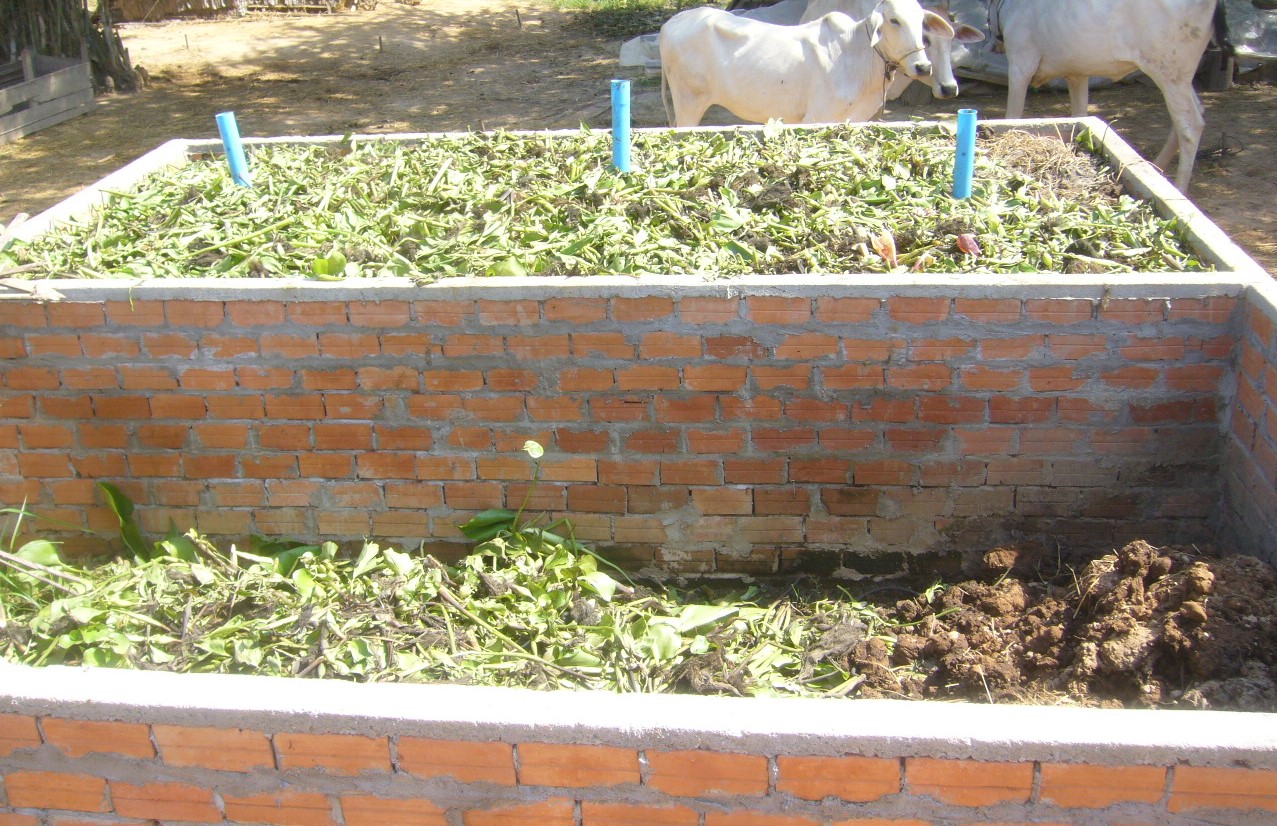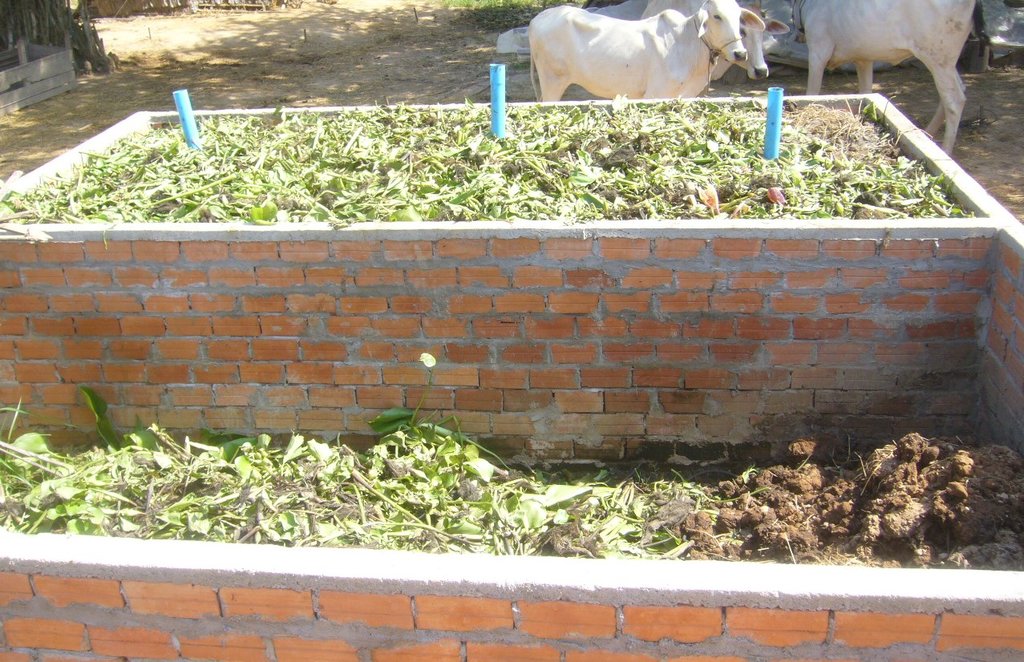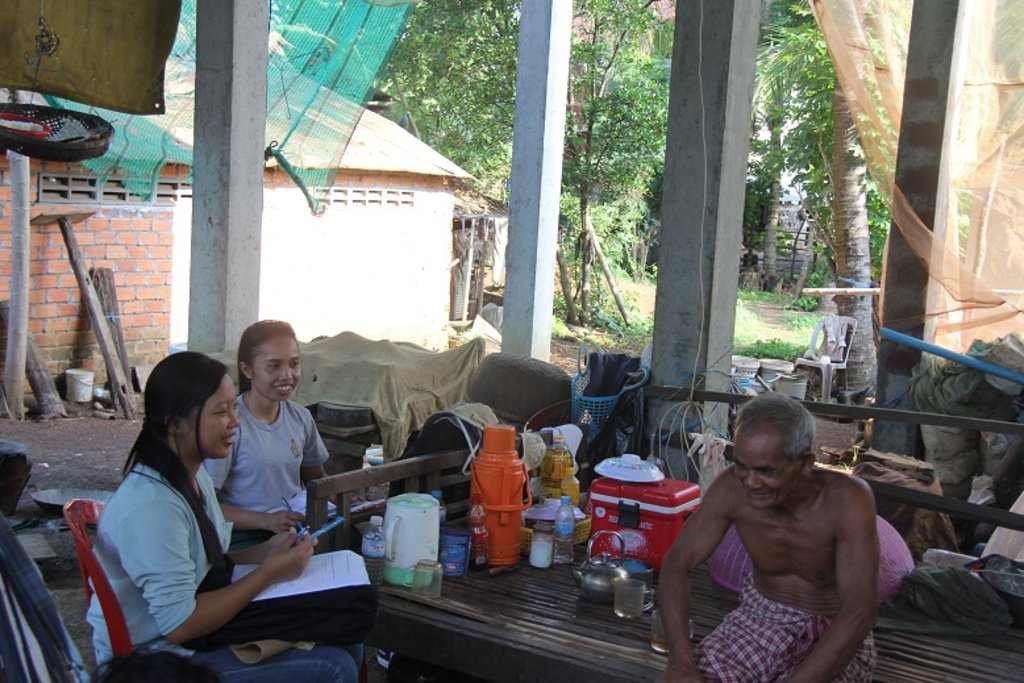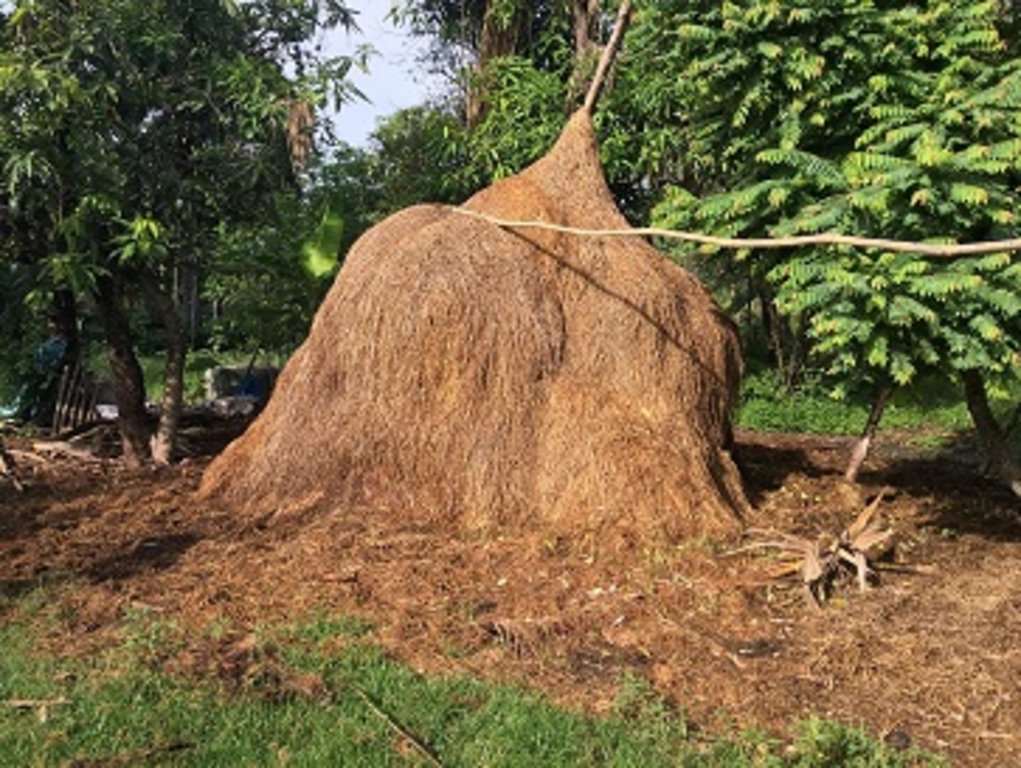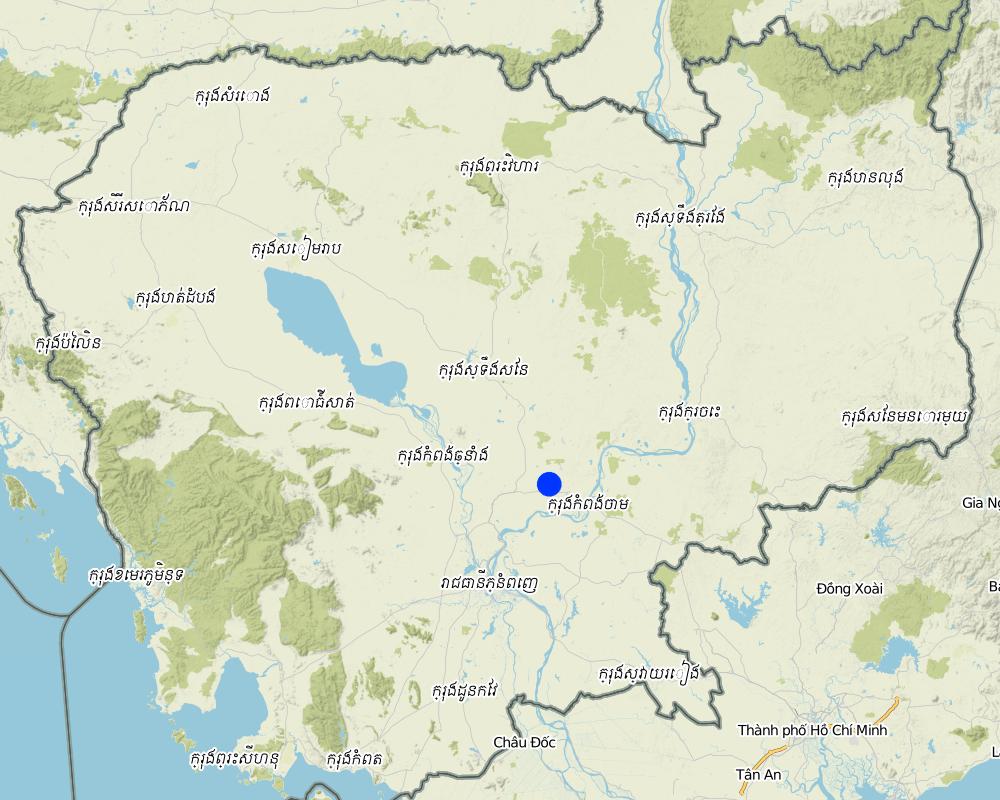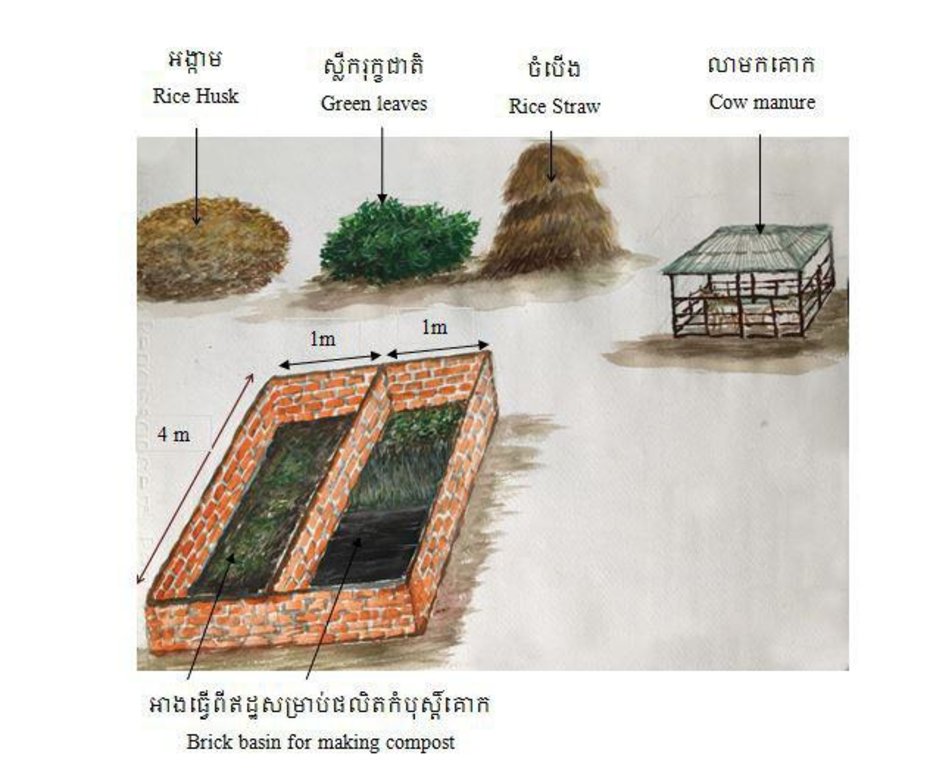ការប្រើប្រាស់ជីកំប៉ុស្តគោកលើដំណាំស្រូវ [Cambodia]
- Creation:
- Update:
- Compiler: Navin Chea
- Editors: Sophea Tim, Sok Pheak
- Reviewers: Nimul CHUN, Ursula Gaemperli
ជីកំប៉ុស្តគោក
technologies_3215 - Cambodia
View sections
Expand all Collapse all1. General information
1.2 Contact details of resource persons and institutions involved in the assessment and documentation of the Technology
Key resource person(s)
land user:
ម៉ុក ម៉ម
(+855) 92 596 851
មិនមានអ៊ីម៉ែល
អ្នកប្រើប្រាស់ដី
ភូមិវត្តចាស់ ឃុំបារាយណ៍ ស្រុកព្រៃឈរ ខេត្តកំពង់ចាម
Cambodia
ប្រធានការិយាល័យកសិកម្ម រុក្ខាប្រមាញ់ និងនេសាទ ស្រុកជើងព្រៃ:
លៀងសុង អ៊ឹម
(+855) 89 755 975
មិនមានអ៊ីម៉ែល
ការិយាល័យកសិកម្ម រុក្ខាប្រមាញ់ និងនេសាទ ស្រុកជើងព្រៃ
ភូមិព្រៃទទឹង ឃុំបារាយណ៍ ស្រុកព្រៃឈរ ខេត្តកំពង់ចាម
Cambodia
Name of project which facilitated the documentation/ evaluation of the Technology (if relevant)
Scaling-up SLM practices by smallholder farmers (IFAD)Name of the institution(s) which facilitated the documentation/ evaluation of the Technology (if relevant)
Royal University of Agriculture (RUA) - Cambodia1.3 Conditions regarding the use of data documented through WOCAT
When were the data compiled (in the field)?
08/05/2017
The compiler and key resource person(s) accept the conditions regarding the use of data documented through WOCAT:
Ja
1.4 Declaration on sustainability of the described Technology
Is the Technology described here problematic with regard to land degradation, so that it cannot be declared a sustainable land management technology?
Nee
2. Description of the SLM Technology
2.1 Short description of the Technology
Definition of the Technology:
ការផលិតជីកំប៉ុស្តគោកដោយផ្សំឡើងពីលាមកគោ ចំបើង អង្កាម ផេះអង្កាម ស្លឹកឈើ កាកសំណល់ពីផ្ទះបាយ និងទឹក ដើម្បីប្រើប្រាស់លើដីស្រែដើម្បីបង្កើនគុណភាពដី និងកាត់បន្ថយការប្រើប្រាស់ជីគីមី។
2.2 Detailed description of the Technology
Description:
ជីកំប៉ុស្ត គឺជាប្រភេទជីធម្មជាតិដែលបានមកពីការរលួយ ឬពុកផុយនៃសារធាតុសរីរាង្គផ្សេងៗ ដែលជួយឱ្យដំណាំលូតលាស់បានល្អជាងការប្រើជីលាមកសត្វ ឬរុក្ខជាតិស្រស់តែមួយមុខៗដោយសារវាបានផលិតឡើងដោយមានសារធាតុសរីរាង្គជាច្រើន។ កសិករអាចផលិតជីកំប៉ុស្តដោយប្រើរយៈពេលខុសៗគ្នា រយៈពេលខ្លី រយៈពេលមធ្យម និងរយៈពេលវែង។ រយៈពេលឆាប់សម្រាប់ការផលិតជីកំប៉ុស្ត គឺត្រឹមតែ១៤ ទៅ១៨ ថ្ងៃ ប៉ុណ្ណោះ គឺអាចយកទៅប្រើប្រាស់បាន រយៈពេលមធ្យម គឺពី ៣ ទៅ ៤ខែ និង រយៈពេលវែងនៃការផលិតកំប៉ុស្ត គឺអាចយកទៅប្រើប្រាស់បានក្រោយរយៈពេល ពី ៥ ទៅ ៦ខែ (CEDAC, 2015)។
ជាទូទៅជីកំប៉ុស្តផ្សំឡើងពីលាមកសត្វ (គោ ក្របី ជ្រូក បសុបក្សី) កាកសំណល់ផ្ទះបាយ ស្លឹករុក្ខជាតិស្រស់ (ដូចជាទន្ទ្រានខែត្រ កំប្លោក ចក សំបកបន្លែ ឬផ្លែឈើ) ។ល។ វានាំមកនូវផលប្រយោជន៍ច្រើនយ៉ាងដូចជា៖ ផ្តល់សារធាតុចិញ្ចឹមដល់រុក្ខជាតិយ៉ាងឆាប់រហ័សបើប្រៀបធៀបការប្រើជាមួយជីស្រស់ ឬជីដែលមិនផុសល្អ។ វាក៏ជាប្រភពនៃមីក្រូសរីរាង្គដែលជួយដល់ដីឱ្យដីមានជីជាតិ ។ ផលិតផលជីកំប៉ុស្ត មិនសូវនាំមកនូវគ្រាប់រុក្ខជាតិផ្សេងៗ ជាពិសេសស្មៅ និងមេរោគ ជំងឺរុក្ខជាតិផ្សេងៗទេដោយពពួកនេះភាគច្រើនត្រូវបានសម្លាប់ក្នុងពេលដែលជីកំពុងពុក ឬកំពុងកាច់ (CEDAC, 2015; YouTube, 2016)។
លោកម៉ម ម៉ុក ដែលជាកសិករក្នុងករណីសិក្សានេះបានអនុវត្តន៍បច្ចេកទេសផលិតជីកំប៉ុស្តគោកតាំងពីឆ្នាំ២០០៨ មក ម្លេះ។ កំប៉ុស្តត្រូវបានផលិតពីវត្ថុធាតុដើមដូចជា៖ ចំបើង លាមកគោ ស្លឹករុក្ខជាតិបៃតង អង្កាម ផេះអង្កាម កាកសំណល់ផ្ទះបាយ និងទឹកជាដើម។ ការផលិតជីកំប៉ុស្តនេះ គឺសំខាន់សម្រាប់ប្រើប្រាស់លើផ្ទៃដីដាំស្រូវ។
ទិសដៅសំខាន់របស់គាត់ក្នុងការផលិតជីកំប៉ុស្ត គឺដើម្បីឱ្យផលិតកម្មដំណាំស្រូវទទួលបានទិន្នផលខ្ពស់ និងមានសុវត្ថិភាពដោយកាត់បន្ថយការប្រើប្រាស់ជីគីមី។ មុនអនុវត្តន៍ការផលិតជីកំប៉ុស្ត គឺផលិតកម្មដំណាំស្រូវទទួលទិន្នផលបានត្រឹមតែ ៤តោន/ហិកតា និងប្រើប្រាស់បរិមាណជីអ៊ុយរ៉េខ្ពស់ ៥បាវ/ហិកតា។ក្រោយពីផ្លាស់ប្តូរការអនុវត្តន៍ការដាំដំណាំស្រូវដោយប្រើជីគីមី មកប្រើប្រាស់ជីកំប៉ុស្ត កសិករសម្គាល់ឃើញថាទិន្នផលស្រូវមានការកើនឡើងដោយអាចទទួលទិន្នផល ៥-៦តោន/ហិកតា និងកាត់បន្ថយការប្រើប្រាស់ជីគីមីមកត្រឹមតែ ១-២ បាវ/ហិកតា តែប៉ុណ្ណោះ។ នេះមានន័យថាការប្រើប្រាស់ជីកំប៉ុស្តបានកាត់បន្ថយការចំណាយលើការទិញជីគីមី។ ម្យ៉ាងវិញទៀតកសិករចំណេញពីការផលិតជីកំប៉ុស្តដោយសារវត្ថុធាតុដើមដូចជា លាមកគោជារបស់ខ្លួនដោយមិនចំណាយថវិកាក្នុងការទិញ និងស្វែងរកវត្ថុធាតុដើមនានាផ្សេងទៀតដែលមានស្រាប់នៅក្នុងតំបន់ដោយពុំចំណាយថវិកា។
បច្ចេកទេសនេះ គឺជាការអនុវត្តន៍មួយដ៏ល្អនៃការគ្រប់គ្រងដីប្រកបដោយចីរភាពក្នុងការបង្កើនជីជាតិដី ដែលធ្វើឱ្យដីស្រែធូរ មិនហាប់ណែន បង្កើនសារធាតុសរីរាង្គដល់ដី ជម្រុញដំណើរការរបស់មីក្រូសរីរាង្គដែលមានប្រយោជន៍ និងងាយស្រួលឱ្យដំណាំស្រូវលុះលូតលាស់បានល្អ។ បញ្ហាប្រឈមក្នុងការផលិតជីកំប៉ុស្តក៏មានជួបប្រទះផងដែរដោយសារតែបរិមាណកំប៉ុស្តដែលផលិតបាន គឺមិនអាចគ្រប់គ្រាន់សម្រាប់ដាក់ដីស្រែទំហំ ១.៣០ ហិកតា នោះទេ ដូចនេះជារៀងរាល់ឆ្នាំកំប៉ុស្តដែលកសិករផលិតបាន គឺដាក់លើផ្ទៃដីតែ ០.៥០-០.៦០ហិកតា តែប៉ុណ្ណោះ ដោយដាក់វិលជុំគ្នាជារៀងរាល់ឆ្នាំលើផ្ទៃដីទាំងអស់ ។ ម្យ៉ាងវិញទៀតការផលិតក៏ត្រូវការចំណាយកម្លាំងពលកម្ម ក្នុងខណៈពេលដែលសមាជិកនៅក្នុងគ្រួសាររបស់លោក ម៉ម ម៉ុក មានការថយចុះក្នុងការដើរប្រមូលវត្ថុធាតុដើម និងត្រួតពិនិត្យជាប្រចាំនៅគ្រប់ដំណាក់កាលនៃការផលិតជីកំប៉ុស្តអំឡុងពេលកំប៉ុស្តកាច់។ គាត់ត្រូវត្រួតពិនិត្យជីកំប៉ុស្តជាប្រចាំ រួមទាំងការបន្ថែមទឹក បន្ថែមវត្ថុធាតុដើម។ បន្ទាប់ពី៣ខែគាត់ត្រូវផ្ទេរកំប៉ុស្តដែលកាច់រួចទៅអាងមួយទៀតសម្រាប់ស្តុកទុក។ ទោះជាយ៉ាងណាក៏ដោយកសិករ នៅតែពេញចិត្ត និងបន្តនូវការផលិតជីកំប៉ុស្តដោយសារវាបានផ្តល់អត្ថប្រយោជន៍ច្រើន។
ការផលិតជីកំប៉ុស្ត គឺធ្វើឡើងដោយការសាងសង់ជាអាងចំនួន២ ធ្វើអំពីឥដ្ឋដែលអាចប្រើប្រាស់បានយូរដោយមិនមានសង់ជារោងនោះទេ ដូចនេះនៅពេលខែវស្សា អាចប្រើប្រាស់តង់គ្របជំនួសវិញ។ ការផលិតជីកំប៉ុស្តគោក មានដំណើរការដូចតទៅ៖ ជំហានទី១ គឺនៅក្នុងអាងទី១ត្រូវរៀបកំទេចចំបើងដែលចិញ្ច្រាំឱ្យល្អិតរួចហើយ និងអង្កាមដោយរៀបដាក់នៅបាតអាងកម្រាស់ ៣០ សង់ទីម៉ែត្ររួចស្រោចទឹកមួយសារដើម្បីឱ្យកំទេចកំទីចំបើង និងអង្កាមជោគទឹកបានល្អ។ ជំហានទី២ ត្រូវយកលាមកគោមកដាក់ពីលើកំទេចកកំទីចំបើងដោយរៀបកម្រាស់ ២០ សង់ទីម៉ែត្រ និងបន្ទាប់មកទៀតរែងផេះអង្កាម ឬផេះដែលបានមកពីផ្ទះបាយដាក់ពីលើលាមកគោរួចហើយធ្វើការស្រោចទឹកម្តងទៀតឱ្យសព្វ។ ជំហានចុងក្រោយ ត្រូវយកស្លឹកទន្ទ្រានខែត្រ ឬស្លឹករុក្ខជាតិបៃតងដែលចិញ្ច្រាំរួចហើយមកដាក់ពីលើស្រទាប់នេះកម្រាស់ ៣០ សង់ទីម៉ែត្រ រួចធ្វើការស្រោចទឹក។ ការរៀបចំជាស្រទាប់ គឺធ្វើឡើងនៅពេលជាមួយគ្នារហូតអាងពេញ។ ការផលិតជីកំប៉ុស្ត គឺមិនប្រកាន់ទៅលើពេលវេលានោះទេ អាស្រ័យទៅលើវត្ថុធាតុដើមដែលមាន និងស្វែងរកបាននៅក្នុងតំបន់រួមជាមួយកម្លាំងពលកម្មក្នុងការចូលរួមផលិត។
ជីកំប៉ុស្តត្រូវបានដឹកជញ្ជូនទៅស្រែតាមរយៈរទេះគោនៅក្នុងអំឡុងចុងខែមេសា ឬខែឧសភា នៅពេលដែលដីស្រែមានភ្លៀងធ្លាក់ខ្លះ ដីស្រែមានសំណើម ជៀសវាងការដាក់ជីកំប៉ុស្តនៅពេលដែលដីស្រែស្ងួត និងមានកម្តៅថ្ងៃក្តៅខ្លាំងដែលអាចប៉ះពាល់គុណភាពរបស់ជីកំប៉ុស្ត។
2.3 Photos of the Technology
2.5 Country/ region/ locations where the Technology has been applied and which are covered by this assessment
Country:
Cambodia
Region/ State/ Province:
ភូមិវត្តចាស់ ឃុំបារាយណ៍ ស្រុកព្រៃឈរ ខេត្តកំពង់ចាម
Map
×2.6 Date of implementation
Indicate year of implementation:
2008
2.7 Introduction of the Technology
Specify how the Technology was introduced:
- through projects/ external interventions
Comments (type of project, etc.):
ការធ្វើជីកំប៉ុស្តនេះចេះតាមរយៈគម្រោង អេរីុកុន ពេលគម្រោងចប់នៅតែបន្តធ្វើវារហូត។
3. Classification of the SLM Technology
3.1 Main purpose(s) of the Technology
- improve production
- reduce, prevent, restore land degradation
- conserve ecosystem
- adapt to climate change/ extremes and its impacts
3.2 Current land use type(s) where the Technology is applied

Cropland
- Annual cropping
Main crops (cash and food crops):
ស្រូវ
If land use has changed due to the implementation of the Technology, indicate land use before implementation of the Technology:
ពីមុនប្រើជីគីមីច្រើន និងលាមកគោតិចតួច។
3.3 Further information about land use
Water supply for the land on which the Technology is applied:
- mixed rainfed-irrigated
Number of growing seasons per year:
- 1
Livestock density (if relevant):
មានចិញ្ចឹមគោ ៥ ក្បាល
3.4 SLM group to which the Technology belongs
- integrated soil fertility management
- waste management/ waste water management
3.5 Spread of the Technology
Specify the spread of the Technology:
- applied at specific points/ concentrated on a small area
3.6 SLM measures comprising the Technology

agronomic measures
- A2: Organic matter/ soil fertility
3.7 Main types of land degradation addressed by the Technology

chemical soil deterioration
- Cn: fertility decline and reduced organic matter content (not caused by erosion)

physical soil deterioration
- Pc: compaction

biological degradation
- Bl: loss of soil life
3.8 Prevention, reduction, or restoration of land degradation
Specify the goal of the Technology with regard to land degradation:
- prevent land degradation
- reduce land degradation
4. Technical specifications, implementation activities, inputs, and costs
4.1 Technical drawing of the Technology
4.2 Technical specifications/ explanations of technical drawing
អាងជីកំប៉ុស្តមានពីរគឺអាងទីមួយមានទំហំ៤ម៉ែត្រការ៉េ (ទទឹង ១ម៉ែត្រ បណ្តោយ ៤ ម៉ែត្រ) សម្រាប់ផលិតជីកំប៉ុស្ត និងអាងទីពីរ មានទំហំ ៤ម៉ែត្រការ៉េ (ទទឹង១ម៉ែត្រ បណ្តោយ៤ម៉ែត្រ) សម្រាប់ស្តារជីកំប៉ុស្តនៅពេលវាកាច់ ជម្រៅអាងទាំង២ គឺជម្រៅ១ម៉ែត្រ។ នៅបាតអាងនីមួយៗមានចោះរន្ធចំនួន ៤ នៅជ្រុងបាតអាងខាងក្រោមសម្រាប់ឱ្យឧស្ម័នចេញ។
អ្នកប្រើប្រាស់ដីផលិតជីកំប៉ុស្ត គឺចាប់ផ្តើមពីខែ ១១ ហើយខែ ០៥ អាចប្រើប្រាស់បាននៅលើផ្ទៃដីស្រែ។
វត្ថុធាតុដើមសម្រាប់ផលិតជាជីកំប៉ុស្តមានដូចជា លាមកគោ ស្លឺករុក្ខជាតិខៀវ អង្កាម ផេះអង្កាម កាកសំណល់ផ្ទះបាយ និងទឹកជាដើម។
4.3 General information regarding the calculation of inputs and costs
Specify how costs and inputs were calculated:
- per Technology unit
other/ national currency (specify):
រៀល
Indicate exchange rate from USD to local currency (if relevant): 1 USD =:
4000.0
Indicate average wage cost of hired labour per day:
25000 រៀល
4.4 Establishment activities
| Activity | Type of measure | Timing | |
|---|---|---|---|
| 1. | ធ្វើអាងជីកំប៉ុស្ត | Structural | ខែ ០៥ |
| 2. | រកវត្ថុធាតុដើម | Management | ខែ០៨ |
| 3. | ដាក់ផេះអង្កាម | Management | ខែ០៨ |
Comments:
នៅក្នុងដំណើរការផលិតជីកំប៉ុស្ត គឺមិនត្រូវឱ្យមានប្លាស្ទិកចូលនោះទេ ប្រសិនបើមានថង់ប្លាស្ទិកនៅក្នុងកំប៉ុស្តវាប៉ះពាល់ដល់ដីស្រែ។
4.5 Costs and inputs needed for establishment
| Specify input | Unit | Quantity | Costs per Unit | Total costs per input | % of costs borne by land users | |
|---|---|---|---|---|---|---|
| Labour | សាងសង់អាងផលិតជីកំប៉ុស្ត | ថ្ងៃ | 4.0 | 15000.0 | 60000.0 | 100.0 |
| Fertilizers and biocides | លាមកគោ | គោយន្ត | 5.0 | 300000.0 | 1500000.0 | 100.0 |
| Construction material | ឥដ្ឋ | ដុំ | 900.0 | 140.0 | 126000.0 | |
| Construction material | ស៊ីម៉ង់ | បេ | 6.0 | 20000.0 | 120000.0 | |
| Construction material | ខ្សាច់ | គីប | 2.0 | 40000.0 | 80000.0 | |
| Construction material | តង់ | ដុំ | 1.0 | 40000.0 | 40000.0 | |
| Construction material | ចបកាប់ | ចបកាប់ | 1.0 | 15000.0 | 15000.0 | 100.0 |
| Construction material | បង្គី | គូ | 1.0 | 4000.0 | 4000.0 | |
| Construction material | កាំបិត | ផ្លែ | 1.0 | 15000.0 | 15000.0 | 100.0 |
| Construction material | ពូថៅ | ផ្លៃ | 1.0 | 10000.0 | 10000.0 | 100.0 |
| Total costs for establishment of the Technology | 1970000.0 | |||||
Comments:
អេរីុកុនជាអ្នកជួយឧបត្ថម្ភថវិកាលើការសាងសង់អាង។ ចំណែកកសិករត្រូវរកវត្ថុធាតុដើមសម្រាប់ផលិតជីកំប៉ុស្តតែប៉ុណ្ណោះ។ ចំពោះវត្ថុធាតុដើមដូចជាលាមកគោ គឺមិនបានទិញនោះទេដោយសារគាត់មានគោខ្លួនឯង ដូចនេះមានការលំបាកក្នុងការកំណត់ថ្លៃ។ ចំណែកផេះអង្កាម ចំបើង និងវត្ថុធាតុដើមផ្សេងទៀត គាត់មិនបានទិញ គឺប្រើប្រាស់វត្ថុធាតុដើមដែលខ្លួមានស្រាប់ និងស្វែងរកនៅក្នុងតំបន់។
4.6 Maintenance/ recurrent activities
| Activity | Type of measure | Timing/ frequency | |
|---|---|---|---|
| 1. | ស្រោចទឹក (ធ្វើដោយខ្លួនឯង) | Management | ពេលវាស្ងួត |
| 2. | ផ្ទេរទៅអាងផ្សេងពេលវាកាច់ | Management | រៀរាល់០២ខែ ឬ០៣ខែម្តង ត្រួតពិនិត្យមើល |
| 3. | បន្ថែមវត្ថូធាតុដើម | Management | ០៣ ខែម្តង |
Comments:
ប្រសិនបើមានកម្លាំងពលកម្មគ្រប់គ្រាន់គេអាចផលិតជីកំប៉ុស្តបាន ៤ដង ក្នុងមួយឆ្នាំ។
4.7 Costs and inputs needed for maintenance/ recurrent activities (per year)
If possible, break down the costs of maintenance according to the following table, specifying inputs and costs per input. If you are unable to break down the costs, give an estimation of the total costs of maintaining the Technology:
200000.0
Comments:
កសិករមិនបានចំណាយប្រាក់ឈ្នួលលើការថែទាំនោះទេដោយសារគាត់ធ្វើដោយខ្លួនឯង ដូចនេះពិបាកក្នុងការគណនាថ្ងៃថែទាំ។
4.8 Most important factors affecting the costs
Describe the most determinate factors affecting the costs:
កសិករមិនបានជួលកម្លាំងពលកម្មខាងក្រៅក្នុងការជួយផលិតកំប៉ុស្តនោះទេ គឺគាត់ធ្វើវាដោយខ្លួនគាត់ផ្ទាល់។ បញ្ហាប្រឈមមួយវិញទៀតខាងផ្នែកហិរញ្ញវត្ថុដោយសារមិនមានថវិកាគ្រប់គ្រាន់ក្នុងការចិញ្ចឹមគោឱ្យបានច្រើនដើម្បីទទួលបានលាមកឱ្យបានគ្រប់គ្រាន់សម្រាប់ផលិតជាជីកំប៉ុស្តនោះទេ។
5. Natural and human environment
5.1 Climate
Annual rainfall
- < 250 mm
- 251-500 mm
- 501-750 mm
- 751-1,000 mm
- 1,001-1,500 mm
- 1,501-2,000 mm
- 2,001-3,000 mm
- 3,001-4,000 mm
- > 4,000 mm
Specify average annual rainfall (if known), in mm:
1095.30
Specifications/ comments on rainfall:
បរិមាណទឹកភ្លៀងឆ្នាំ ២០១៥ មានចំនួន ១០៩៥.៣០ ម.ម ចំណែកនៅឆ្នាំ២០១៤ មានរហូតដល់ ១៣២២.១ ម.ម រីឯឆ្នាំ ២០១៣ មានចំនួន ១៤៦៦.៩ ម.ម។
Indicate the name of the reference meteorological station considered:
ក្រសួងធនធានទឹក និងឧត្ដុនិយម (២០១៥)
Agro-climatic zone
- sub-humid
5.2 Topography
Slopes on average:
- flat (0-2%)
- gentle (3-5%)
- moderate (6-10%)
- rolling (11-15%)
- hilly (16-30%)
- steep (31-60%)
- very steep (>60%)
Landforms:
- plateau/plains
- ridges
- mountain slopes
- hill slopes
- footslopes
- valley floors
Altitudinal zone:
- 0-100 m a.s.l.
- 101-500 m a.s.l.
- 501-1,000 m a.s.l.
- 1,001-1,500 m a.s.l.
- 1,501-2,000 m a.s.l.
- 2,001-2,500 m a.s.l.
- 2,501-3,000 m a.s.l.
- 3,001-4,000 m a.s.l.
- > 4,000 m a.s.l.
Indicate if the Technology is specifically applied in:
- not relevant
5.3 Soils
Soil depth on average:
- very shallow (0-20 cm)
- shallow (21-50 cm)
- moderately deep (51-80 cm)
- deep (81-120 cm)
- very deep (> 120 cm)
Soil texture (topsoil):
- medium (loamy, silty)
Soil texture (> 20 cm below surface):
- medium (loamy, silty)
Topsoil organic matter:
- medium (1-3%)
If available, attach full soil description or specify the available information, e.g. soil type, soil PH/ acidity, Cation Exchange Capacity, nitrogen, salinity etc.
ដីជម្រៅ ៣ ម៉ែត្រជាថ្មស និងថ្មខ្មៅ
5.4 Water availability and quality
Ground water table:
< 5 m
Availability of surface water:
good
Water quality (untreated):
poor drinking water (treatment required)
Is water salinity a problem?
Nee
Is flooding of the area occurring?
Ja
Regularity:
episodically
Comments and further specifications on water quality and quantity:
ទឹកត្រូវធ្វើការចម្រោះ ហើយយកមកដាំឱ្យពុះទើបមានសុវត្ថិភាពក្នុងការបរិភោគ។
5.5 Biodiversity
Species diversity:
- medium
Habitat diversity:
- low
5.6 Characteristics of land users applying the Technology
Sedentary or nomadic:
- Sedentary
Market orientation of production system:
- mixed (subsistence/ commercial
Off-farm income:
- less than 10% of all income
Relative level of wealth:
- average
Individuals or groups:
- individual/ household
Level of mechanization:
- manual work
Gender:
- men
Age of land users:
- elderly
Indicate other relevant characteristics of the land users:
កសិករអាយុ ៦៦ ឆ្នាំ។
5.7 Average area of land owned or leased by land users applying the Technology
- < 0.5 ha
- 0.5-1 ha
- 1-2 ha
- 2-5 ha
- 5-15 ha
- 15-50 ha
- 50-100 ha
- 100-500 ha
- 500-1,000 ha
- 1,000-10,000 ha
- > 10,000 ha
Is this considered small-, medium- or large-scale (referring to local context)?
- medium-scale
Comments:
ដីស្រែផ្ទាល់ខ្លួន ០.៧០ហិកតា ដីស្រែជួលគេ ០.៨០ ហិកតា។
5.8 Land ownership, land use rights, and water use rights
Land ownership:
- individual, titled
- ដីជួលគេ
Land use rights:
- leased
- individual
Water use rights:
- open access (unorganized)
5.9 Access to services and infrastructure
health:
- poor
- moderate
- good
education:
- poor
- moderate
- good
technical assistance:
- poor
- moderate
- good
employment (e.g. off-farm):
- poor
- moderate
- good
markets:
- poor
- moderate
- good
energy:
- poor
- moderate
- good
roads and transport:
- poor
- moderate
- good
drinking water and sanitation:
- poor
- moderate
- good
financial services:
- poor
- moderate
- good
6. Impacts and concluding statements
6.1 On-site impacts the Technology has shown
Socio-economic impacts
Production
crop production
Quantity before SLM:
៤ តោន/ហិកតា
Quantity after SLM:
៥ -៦ តោន/ហិកតា
crop quality
Quantity before SLM:
៤០%
Quantity after SLM:
៨០%
Comments/ specify:
ដំណាំមានគុណភាពល្អពេលប្រើប្រាស់ជីកំប៉ុស្ត ហើយដីមានសំណើមល្អ។
risk of production failure
Comments/ specify:
ហានិភ័យលើផលិតកម្មមានការថយចុះដោយសារគាត់អាចផលិតនូវដំណាំដែលមានគុណភាពល្អដោយប្រើប្រាសស់ធាតុចូលកសិកម្មនៃជីគីមីទាប និងអាចតម្រូវទៅតាមទីផ្សាររបស់អ្នកទិញ។ ស្រូវរបស់គាត់ដែលដាំដុះដោយប្រើប្រាស់ជីកំប៉ុស្តអាចលក់បាននៅក្នុងតម្លៃខ្ពស់។ ឧទាហរណ៍៖ ស្រូវផ្ការំដួអាចលក់បានក្នុងតម្លៃ ១៥០០ រៀល/គ.ក ប៉ុន្តែប្រសិនគាត់ប្រើប្រាស់ជីគីមីខ្ពស់គាត់អាចលក់បានត្រឹមតម្លៃប្រហែល ១០០០ រៀល/គ.ក តែប៉ុណ្ណោះ។
Income and costs
expenses on agricultural inputs
Comments/ specify:
វត្ថុធាតុដើមដូចជាលាមកគោ ចំបើង ផេះ គឺមានផ្ទាល់ខ្លួន ចំណែកវត្ថុធាតុដើមផ្សេងទៀតអាចដើររកបាននៅក្នុងតំបន់ ដោយមិនចាំបាច់ចំណាយថវិកាឡើយ។
farm income
Comments/ specify:
ដោយសារទទួលបានទិន្នផលខ្ពស់។
workload
Socio-cultural impacts
food security/ self-sufficiency
health situation
Comments/ specify:
ដំណាំមានគុណភាពល្អដោយប្រើប្រាស់ធាតុចូលកសិកម្មនៃជីគីមីទាបដែលល្អសម្រាប់សុខភាព។
SLM/ land degradation knowledge
Comments/ specify:
ប្រើប្រាស់ជីកំប៉ុស្តកាត់បន្ថយឱនភាពដី។ ដីធូរជាងមុន និងបង្កើនមីក្រូសរីរាង្គនៅក្នុងដីដូចជា ជន្លេនជាដើម។
Ecological impacts
Water cycle/ runoff
water quantity
water quality
Comments/ specify:
ប្រសិនប្រើជីគីមីគឺប៉ះពាល់ដល់ទឹក ដី
Soil
soil moisture
Comments/ specify:
តាមការសម្គាល់របស់កសិករ ដីដែលប្រើជីកំប៉ុស្តនៅពេលដែលគាត់ជីកដីនៅស្រទាប់ខាងក្នុង គឺមានសំណើម។
soil crusting/ sealing
Comments/ specify:
ធ្វើឱ្យប្រសើរឡើងនូវវាយនភាពរបស់ដី និងទម្រង់របស់ដី។
soil compaction
nutrient cycling/ recharge
Comments/ specify:
កំប៉ុស្តធ្វើឱ្យដីសម្បូរជន្លេន
soil organic matter/ below ground C
Comments/ specify:
បង្កើនភាវរស់នៅក្នុងដីដូចជា៖ ជន្លេន ខ្ចង កង្កែប សត្វស្រមោច ពីងពាង សត្វកណ្តៀរ។ល។
Biodiversity: vegetation, animals
plant diversity
Comments/ specify:
ជីកំប៉ុស្តផ្តល់អត្ថប្រយោជន៍ដល់ពូជស្រូវផ្សេងៗគ្នា។ ឧទាហរណ៍៖ ដាំស្រូវពូជផ្ការំដួល ឬពូជស្រូវរាំងជ័យ ដំណាំដុះលូតលាស់ល្អ និងទទួលបានទិន្នផលខ្ពស់។
beneficial species
Comments/ specify:
កើនឡើងនូវសត្វជន្លេន ខ្ចង សត្វស្រមោច សត្វកណ្តៀរ ជាដើម។ល។
6.2 Off-site impacts the Technology has shown
damage on neighbours' fields
6.3 Exposure and sensitivity of the Technology to gradual climate change and climate-related extremes/ disasters (as perceived by land users)
Gradual climate change
Gradual climate change
| Season | Type of climatic change/ extreme | How does the Technology cope with it? | |
|---|---|---|---|
| annual temperature | increase | well | |
| annual rainfall | decrease | moderately | |
| seasonal rainfall | wet/ rainy season | increase | well |
Climate-related extremes (disasters)
Biological disasters
| How does the Technology cope with it? | |
|---|---|
| epidemic diseases | moderately |
| insect/ worm infestation | moderately |
6.4 Cost-benefit analysis
How do the benefits compare with the establishment costs (from land users’ perspective)?
Short-term returns:
positive
Long-term returns:
positive
How do the benefits compare with the maintenance/ recurrent costs (from land users' perspective)?
Short-term returns:
positive
Long-term returns:
very positive
6.5 Adoption of the Technology
- 10-50%
If available, quantify (no. of households and/ or area covered):
មានចំនួន ១៥គ្រួសារដែលអនុវត្តន៍ការផលិតជីកំប៉ុស្តនេះ។
Of all those who have adopted the Technology, how many have did so spontaneously, i.e. without receiving any material incentives/ payments?
- 10-50%
Comments:
មាន១៥គ្រួសារកំពុងផលិតជីកំប៉ុស្តដោយមានការគាំទ្រពីអេរ៉ីកុន។ អេរ៉ីកុនគាំទ្រទៅលើការសាងសង់អាងផលិតជីកំប៉ុស្តចំនួន ២អាង ហើយកសិករចំណាយទៅលើវត្ថុធាតុដើមក្នុងការផលិតជីកំប៉ុស្ត។
6.6 Adaptation
Has the Technology been modified recently to adapt to changing conditions?
Ja
other (specify):
បង្កើនជីជាតិដី
Specify adaptation of the Technology (design, material/ species, etc.):
១៥ គ្រួសារនៃអ្នកប្រើប្រាស់ដីត្រូវបានអនុវត្តន៍បច្ចេកទេសដោយមានការគាំទ្រពីគម្រោងរបស់អង្គការអេរ៉ីកុន តែទោះយ៉ាងណានៅពេលដែលគម្រោងនេះបានបញ្ចប់ កសិករនៅបន្តការផលិតជីកំប៉ុស្តដដែល។
6.7 Strengths/ advantages/ opportunities of the Technology
| Strengths/ advantages/ opportunities in the land user’s view |
|---|
| ធ្វើឱ្យដីធូរ មិនក្តាំង និងមិនហាប់ណែន។ |
| ថយចុះនូវការប្រើប្រាស់ជីគីមី។ |
| វត្ថុធាតុដើមក្នងការផលិតជីកំប៉ុស្តអាចរកបាននៅក្នុងតំបន់ដោយមិនចំណាយថវិកាឡើយ។ |
| Strengths/ advantages/ opportunities in the compiler’s or other key resource person’s view |
|---|
| ជីកំប៉ុស្តផ្តល់នូវមីក្រូសរីរាង្គជួយឱ្យដីមានជីជាតិល្អ ដីធូរ ដីផុស ដីមិនហាប់ណែន ដែលធ្វើឱ្យដំណាំស្រូវងាយស្រូបយកសារធាតុចិញ្ចឹម។ |
| កាត់បន្ថយការចំណាយលើការទិញជីគីមីដែលអាចជួយឱ្យជីវភាពរបស់កសិករប្រសើរឡើង និងទទួលបានផលិតផលដែលមានសុវត្ថិភាព(ស្រូវ)។ |
| កសិករមានគោខ្លួនឯង ចំបើង អង្កាម និងវត្ថុធាតុដើមផ្សេងទៀតអាចរកបាននៅក្នុងតំបន់ដោយមិនចាំបាច់ចំណាយថវិកាក្នុងការទិញវត្ថុធាតុដើម។ |
6.8 Weaknesses/ disadvantages/ risks of the Technology and ways of overcoming them
| Weaknesses/ disadvantages/ risks in the land user’s view | How can they be overcome? |
|---|---|
| ខ្វះកម្លាំងពលកម្មក្នងដំណើរការផលិតដូចជាការស្វែងរកសមាសធាតុសរីរាង្គពីទីកន្លែងផ្សេង កម្លាំងពលកម្មក្នុងការជួយចិញ្ច្រាំវត្ថុធាតុដើមដូចជាចំបើង ស្លឹករុក្ខជាតិ ។ល។ | ធ្វើបន្តិចៗម្តង។ ធ្វើទៅតាមដំណាក់កាល និងលទ្ធភាពដែលមាន។ |
|
ត្រូវការយកចិត្តទុកដាក់លើការថែទាំ ព្រោះបើមិនមានការត្រួតពិនិត្យឱ្យបានល្អនោះកំប៉ុស្តមិនកាច់ល្អនោទេ។ |
ត្រូវត្រួតពិនិត្យវាជាប្រចាំ ការថែមទឹកនៅពេលស្ងួត ត្រូវកាយត្រឡប់ផ្នែកណាដែលបានកាច់ផ្ទេរទៅអាងបន្ទាប់។ |
| ត្រូវទឹកភ្លៀងឬដាក់ទឹកជ្រុលវាមិនកាច់ល្អនោះទេ។ | គ្របតង់នៅខែវស្សា និងត្រួតពិនិត្យលើបរិមាណទឹកកុំឱ្យច្រើនហួសកម្រិត។ |
| Weaknesses/ disadvantages/ risks in the compiler’s or other key resource person’s view | How can they be overcome? |
|---|---|
| ត្រូវចំណាយកម្លាំងពលកម្មច្រើន ព្រមទាំងពេលវេលាក្នុងខណៈពេលដែលសមាជិកគ្រួសារមានការថយចុះ។ | ត្រូវឧស្សាហ៍ព្យាយាម និងអំណត់។ |
| ការផលិតជីកំប៉ុស្តទាមទារឱ្យមានការបណ្តុះបណ្តាលត្រឹមត្រូវព្រោះប្រសិនមិនមានការបណ្តុះបណ្តាលលើការផលិតជីកំប៉ុស្ត កសិករដែលរៀនខ្លួនឯង ឬពីកសិករដ៏ទៃទៀត អាចនឹងមិនទទួលបានផលិតផលកំប៉ុស្តដែលមានគុណភាពល្អ។ | ជំរុញឱ្យមានការបណ្តុះបណ្តាល ឬមានការអនវុត្តន៍ជាក់ស្តែង។ |
| បរិមាននៃការផលិតជីកំប៉ុស្តមិនអាចគ្រប់គ្រាន់ទៅតាមទំហំផ្ទៃដីស្រែទាំងអស់ដែលមាននោះទេ។ | ធ្វើការដាក់ជីកំប៉ុស្តវិលជុំទៅលើស្រែដែលមាន។ |
7. References and links
7.1 Methods/ sources of information
- field visits, field surveys
ចំនួន៥ កន្លែង
- interviews with land users
១ នាក់
- interviews with SLM specialists/ experts
២ នាក់
- compilation from reports and other existing documentation
7.2 References to available publications
Title, author, year, ISBN:
CEDAC. (2015). Kit of simple Agriculture Technologies. Phnom Penh.
Available from where? Costs?
មជ្ឈមណ្ឌលសិក្សា និងអភិវឌ្ឈន៍កសិកម្មកម្ពុជា (CEDAC). 10000 Riels
7.3 Links to relevant information which is available online
Title/ description:
yutube. (2016). Compost fertilizer, Cambodia. Retrieved June 6, 2017, from
URL:
https://video.search.yahoo.com/search/video;_ylt=A0LEVzNzS.BZYvMAdaJXNyoA;_ylu=X3oDMTEyNWNiaW4yBGNvbG8DYmYxBHBvcwMxBHZ0aWQDQjI5NDRfMQRzZWMDc2M-?p=Making+dry+compost+in+cambodia&fr=tightropetb#action=view&id=4&vid=62cb521e7ee9d4cda885eb335043bb32
Links and modules
Expand all Collapse allLinks
No links
Modules
No modules


